On Monday 28 July the topsides were lifted into place on the steel jacket on the Valemon field in the North Sea.
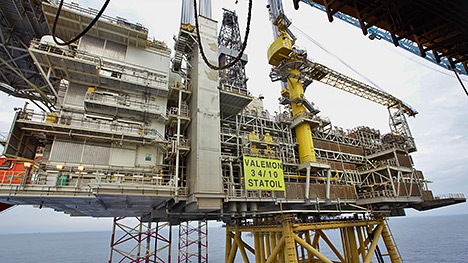
The Valemon topsides landed on the jacket just before 13.00. (Photo: André Osmundsen/Statoil)
Produced by Samsung Heavy Industries this is the first Statoil topsides built in South Korea.
The structure sailed from the yard on 15 June this year, and after a quick stop in Åmøyfjorden, Stavanger, last Saturday, it headed out to the field. The transportation to Norway took 40 days.
"This is a major milestone for the project, the most important milestone of course being start-up towards the end of the year," says Bjørn Laastad, vice president for Valemon field development.
The lift of the 9 750-tonne topsides took two hours, and was performed slightly earlier than initially assumed.
Thanks to good weather in the North Sea this summer, the Saipem 7000 crane vessel was available for lifting once the topsides arrived in Norway. The weather was favorable also when the crane vessel and the topsides arrived on the field.
"We had almost perfect lifting conditions," Viktor Nilsen-Nygaard, head of Valemon transportation and installation, reports from the crane vessel.
After the topsides were lifted into place, the flare boom was installed.
VIDEO: Valemon in Åmøyfjorden. Prior to the heavy lift the Valemon topsides visited Åmøyfjorden in Stavanger. https://www.youtube.com/watch?v=pjT7cld8KjU
Precision work
The more than two-year planning period has included very thorough safety evaluations for all phases of the lifting operation. From mid-June the West Elara rig pre-drilled production wells through the jacket on the field.
The rig's derrick has been pulled in during the lifting operations. During the lift the distance between the topsides and rig was just five meters.
The well operations will resume in mid-October. According to plan three wells will be producing when the field comes on stream at the end of the year. The rig's job, however, will be far from finished. Drilling on the field is planned to continue until 2017.
Hook-up
In the months ahead commissioning work will take place on the field. Wells will be hooked up with production facilities on board, sea water pumps will be installed, and electricity, water and pipelines will be connected.
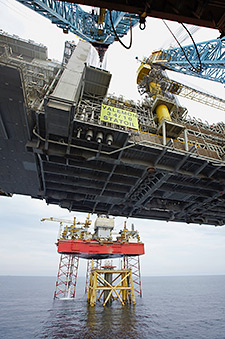 Two hours after the Valemon topsides were lifted off the transport vessel, the structure landed on its feet. (Photo: André Osmundsen/Statoil)
Two hours after the Valemon topsides were lifted off the transport vessel, the structure landed on its feet. (Photo: André Osmundsen/Statoil)
Valemon will be powered from Kvitebjørn, and the cable has already been laid on the seabed. So have the pipelines that will be transporting gas and condensate to Heimdal and Kvitebjørn, respectively.
"Some work remains before we are ready for start-up, but we are on track," says Laastad.
In order to accommodate everyone involved in the commissioning and hook-up work Statoil has chartered a flotel.
The project thus has bed capacity for some 400 people, which is the number expected to be offshore, at least in the most hectic period. But there is one thing that cannot be planned – and that's the weather.
"If we get much poor weather the flotel must be disconnected in periods. Poor weather also creates problems for the helicopter traffic, and may delay the commissioning work. So far, however, we have been lucky with the weather, and I hope this continues", says Laastad.
Win-win
Valemon will utilize existing installations and pipelines for gas and condensate export. The gas from Valemon will be transported through the existing pipeline from Huldra to Heimdal, which is a hub for transportation further to the gas markets in Europe.
The condensate will be piped to Kvitebjørn for stabilization, and transported from there to the Mongstad refinery near Bergen.
This is a win-win situation which reduces the costs for the Valemon development, and gives Heimdal and Kvitebjørn new tasks. At Heimdal major upgrading has taken place which significantly extends the platform's life.
Facts about the Valemon Field
- Gas and condensate field in the North Sea, between Kvitebjørn and Gullfaks South. The field is located some 160 kilometers west of Bergen.
– The recoverable reserves on the Valemon field are estimated at 192 million barrels of oil equivalent.
– When all wells have been drilled in 2017 Valemon will become a normally unmanned platform, remotely controlled from Sandsli in Bergen. This is the first Statoil-operated platform to be remotely controlled from land.
– The plan for development and operation (PUD) of the Valemon field was approved by the Ministry of Petroleum and Energy in June



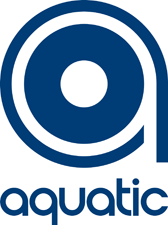 Aquatic Asia Pacific Pte Ltd,
Aquatic Asia Pacific Pte Ltd,
 Two hours after the Valemon topsides were lifted off the transport vessel, the structure landed on its feet. (Photo: André Osmundsen/Statoil)
Two hours after the Valemon topsides were lifted off the transport vessel, the structure landed on its feet. (Photo: André Osmundsen/Statoil) The downing of flight MA17 has prompted calls for further sanctions on Russia targeted at its energy sector. Russia is the world's largest exporter of natural gas and second largest exporter of oil which together account for near 60% of its export earnings. Gazprom supplies 30% of Europe's gas - some 15% via Ukraine - and has warned exports will be affected if sanctions are expanded. But in its payments row with Ukraine Gazprom has already stated that it will "only be supplying the exact amount of gas requested by our European partners to the Russia-Ukraine border". Considering that Ukraine itself needs to draw gas supplies from the same pipelines, Europe is already threatened with gas shortages.
The downing of flight MA17 has prompted calls for further sanctions on Russia targeted at its energy sector. Russia is the world's largest exporter of natural gas and second largest exporter of oil which together account for near 60% of its export earnings. Gazprom supplies 30% of Europe's gas - some 15% via Ukraine - and has warned exports will be affected if sanctions are expanded. But in its payments row with Ukraine Gazprom has already stated that it will "only be supplying the exact amount of gas requested by our European partners to the Russia-Ukraine border". Considering that Ukraine itself needs to draw gas supplies from the same pipelines, Europe is already threatened with gas shortages.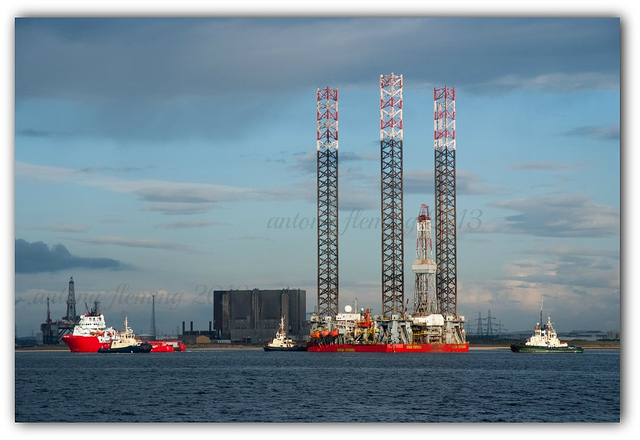 Northern Offshore, Ltd.
Northern Offshore, Ltd.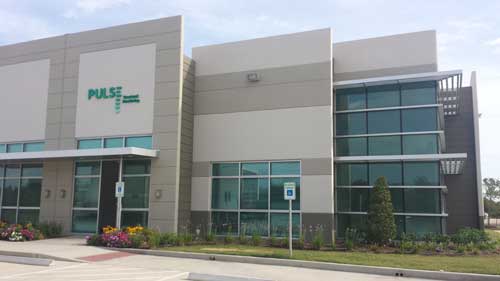 Pulse Structural Monitoring Inc.,
Pulse Structural Monitoring Inc., 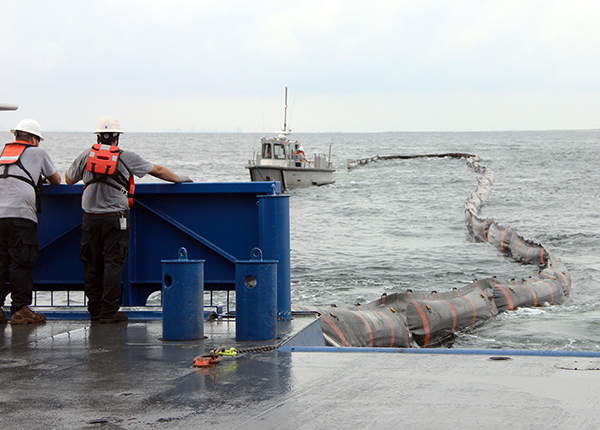 The Bureau of Safety and Environmental Enforcement (BSEE)
The Bureau of Safety and Environmental Enforcement (BSEE)  NYC-based
NYC-based 
 Forum Energy Technologies, Inc.
Forum Energy Technologies, Inc. 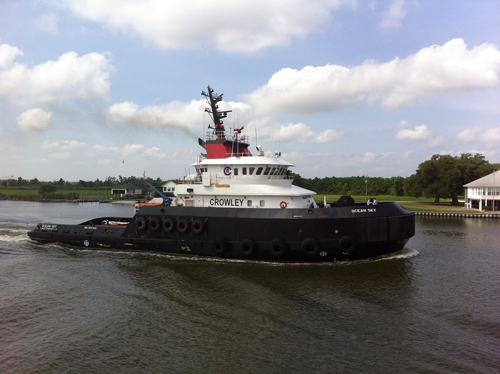 – Ocean Sky –on July 24th, in Houston.
– Ocean Sky –on July 24th, in Houston.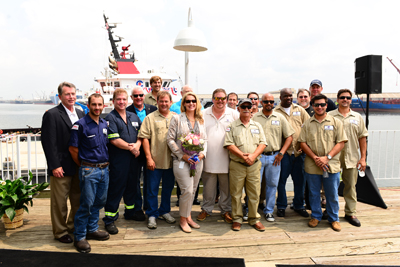 to approximately 140 guests. He was followed by a series of speakers including Joe Huley, vice president, NC Power Systems, and Bruce Greshman, vice president, Heerema Marine Contractors, a Crowley customer who spoke about the 20-year relationship the two companies have enjoyed – a relationship, he remarked was based on "mutual trust, cooperation and responsibility to achieve the same goals."
to approximately 140 guests. He was followed by a series of speakers including Joe Huley, vice president, NC Power Systems, and Bruce Greshman, vice president, Heerema Marine Contractors, a Crowley customer who spoke about the 20-year relationship the two companies have enjoyed – a relationship, he remarked was based on "mutual trust, cooperation and responsibility to achieve the same goals."
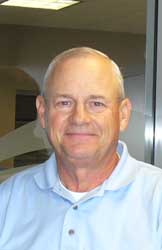

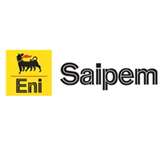 Saipem
Saipem  Global oil demand in 2014 is forecast to increase by about 1.2 million barrels per day (mmbd) compared to 2013 levels, while non-Organization of the Petroleum Exporting Countries (OPEC) members' production will grow by approximately 1.6 mmbd, reducing the call for OPEC production, according to research and consulting firm GlobalData.
Global oil demand in 2014 is forecast to increase by about 1.2 million barrels per day (mmbd) compared to 2013 levels, while non-Organization of the Petroleum Exporting Countries (OPEC) members' production will grow by approximately 1.6 mmbd, reducing the call for OPEC production, according to research and consulting firm GlobalData. Danos
Danos